Western Australia’s Pilbara region is set to be home to the first major iron ore mining operation in Australia to be run entirely off renewable energy during the day. The Chichester mining hub run by resources giant Fortescue Metals will be powered by a massive solar farm coupled with a grid-scale battery.
The Chichester Solar Gas Hybrid project will be developed by power utility Alinta Energy. It will involve a 60 MW solar farm at the hub, 35 MW/11 MWh battery facility and a transmission line linking its Cloudbreak and Christmas Creek mines with Alinta Energy’s 145 MW Newman gas-fired power station. The project is due for completion mid-2021.
As the offtaker of the project, Fortescue will be able to reduce the use of diesel by around 100 million litres annually, as the mines currently rely on diesel generators. This will allow up to 100% of daytime energy requirements for the Chichester operations to be powered by renewable energy, with the remaining power requirements to be balanced with gas generation.
“This landmark project is a first on this scale for the Pilbara and will reduce carbon emissions from stationary generation by around 40% at Fortescue’s Christmas Creek and Cloudbreak mining operations, while driving long-term sustainable cost reductions to maintain Fortescue’s global cost leadership position,” Fortescue CEO, Elizabeth Gaines said.
According to her, Fortescue will invest around $US250 million in energy transmission infrastructure for the project, which would complete the integration of the miner’s Pilbara iron ore operations into an efficient energy network.
To execute the project, Alinta Energy will receive $24.2 million in funding from the Australian Renewable Energy Agency (ARENA), and $90 million from the Northern Australia Infrastructure Facility (NAIF), subject to ratification from the WA government.
ARENA CEO Darren Miller said the project could unlock further investment in renewable energy in the mining sector and other remote and energy intensive operations.
“Alinta’s project will demonstrate how renewable energy solutions can deliver critical energy requirements for major mining operations and help reduce emissions,” he said. “This will also show how interconnection of loads and different generation and storage – including solar, battery storage and gas – can provide secure and reliable electricity.”
Two other Western Australian mines have announced their shift to renewables earlier this year. Agnew Gold Mining is installing an 18 MW wind farm, a 10,000 panel 4 MW solar farm and a 13 MW / 4 MWh battery storage alongside a 16 MW gas engine power station, while a 2.5 MW wind farm, a 1 MW solar farm and a 2 MW / 0.5 MWh battery which will provide up to 70% of the electricity needs of a nearby garnet mining and processing plant run by GMA Garnet.
The announcements reflect a growing trend in powering mining operations worldwide with wind and solar. Presently, Australia’s largest solar PV installation at the mining site is the DeGrussa project – a hybrid system at Sandfire’s copper and gold mine site in Western Australia, which comprises a 10.6 MW solar facility coupled with a 6 MWh battery facility – integrated with an existing diesel generator. The project reached full operation in May 2016.
Other notable off-grid installations in the Australian mining sector include: a 7.3 MW solar array and 2 MW/1 MWh battery at the Granny Smith gold mine in Western Australia’s Eastern Goldfields region, a 3 MW solar farm at the Cannington silver and lead mine in north-west Queensland, and a 6.7 MW solar PV array at the Nova mine in Western Australia.
This content is protected by copyright and may not be reused. If you want to cooperate with us and would like to reuse some of our content, please contact: editors@pv-magazine.com.




Although wind is mentioned (grudgingly) it does not seem to be part of the plan in general for energy generation for mines (it seems to be mainly PV)
Why?
Is this because the wind is not reliable in the Pilbara? or is there another technical reason?
I am also interested in why wave power is not being used as well
regards, Peter Eburne
I would be guessing that, particularly in an area as dry as the Pilbara, the output from solar PV is very predictable. An important considerations when working in a hybrid with backup generators.